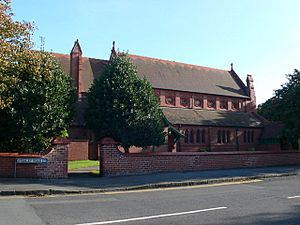St Hildeburgh's Church, Hoylake facts for kids
Quick facts for kids St Hildeburgh's Parish Church, Hoylake |
|
|---|---|

St Hildeburgh's Church, Hoylake, from the north
|
|
| Lua error in Module:Location_map at line 420: attempt to index field 'wikibase' (a nil value). | |
| OS grid reference | SJ 214 889 |
| Location | Stanley Road, Hoylake, Wirral, Merseyside |
| Country | England |
| Denomination | Anglican |
| Churchmanship | [[]] |
| Website | St Hildeburgh, Hoylake |
| History | |
| Status | Parish church |
| Dedication | Saint Hildeburgh |
| Architecture | |
| Functional status | Active |
| Heritage designation | Grade II |
| Designated | 17 October 1986 |
| Architect(s) | Edmund Kirby |
| Architectural type | Church |
| Style | Gothic Revival |
| Groundbreaking | 1897 |
| Completed | 1899 |
| Specifications | |
| Materials | Red brick and terracotta, tiled roof |
| Administration | |
| Parish | Holy Trinity Church, Hoylake |
| Deanery | Wirral, North |
| Archdeaconry | Chester |
| Diocese | Chester |
| Province | York |
St Hildeburgh's Parish Church is a beautiful old church located in Stanley Road, Hoylake, Wirral, Merseyside, England. It is an active Anglican church, which means it is part of the Church of England. The church is a very special building because it is listed as a Grade II heritage site. This means it is important to protect its history and unique architecture.
Contents
History of St Hildeburgh's
The area where Hoylake is now used to be part of a larger parish called West Kirby. In the 1700s, Hoylake became a popular place for people to visit the seaside. A powerful family called the Stanleys helped Hoylake grow. They built the first hotel in 1792 and even a racecourse.
As more people moved to Hoylake, they needed a church. So, in 1833, Holy Trinity Church was opened. By 1860, Hoylake became its own separate parish. The population kept growing, especially after a railway line opened in 1866, connecting Hoylake to bigger cities like Liverpool.
By the 1890s, Holy Trinity Church was too small for everyone. Because of this, St Hildeburgh's Church was built as a second, larger church. It was constructed between 1897 and 1899 on land given by Lord Stanley. A famous architect from Liverpool, Edmund Kirby, designed the church.
Worship and Services
St Hildeburgh's offers different types of church services. They have modern services, like Holy Communion, and also more traditional ones, like choral evensong, which uses older language from the Book of Common Prayer.
The church also has special events for families, like "Messy Church" days. They hold informal "Open Worship" sessions in the Church Centre, which is a modern building behind the main church. The church believes in including everyone and has services for all ages.
Community Role
St Hildeburgh's Church is very involved with the local community. It has strong connections with Hoylake Holy Trinity primary school. The church helps with school services and its team leads worship there.
The church also works with the local Royal National Lifeboat Institution (RNLI), which helps people at sea. The vicar of St Hildeburgh's is even the chaplain for the lifeboat crew. The church also connects with many care homes in Hoylake.
Many community activities happen at the St Hildeburgh's Church Centre. These include:
- A weekly "drop-in" session on Tuesday mornings for anyone to visit.
- A group for young people called "Voyagers."
- A weekly play and worship session for young children and their parents or carers.
- A monthly lunch club for older people.
- Soup and sandwich lunches for care home residents and their families.
Architecture of the Church
St Hildeburgh's Church is built from red brick and terracotta, with tiled roofs. It has a classic church design with a long main area called a nave. It also has side sections called aisles.
Outside the Church
The church has many interesting windows. Along the sides of the aisles, you can see pairs and groups of three tall, narrow windows called lancet windows. Higher up, there are round windows called octofoils.
At the west end of the church, there are strong supports called buttresses that rise above the roof. The porch, where you enter, is made of wood on a brick base. The east window is special, with a cross in the middle and clover-shaped designs around it.
Inside the Church
Inside, the main area has tall arches supported by round pillars made of shiny granite. There is a low screen separating the main part of the church from the chancel, which is where the altar is.
The pulpit, where the preacher stands, is made of wood and beautifully carved. It has a special top part called a sounding board. The wooden screen behind the altar, called a reredos, is also richly carved. It has a picture of the Good Shepherd made from tiles and mosaic.
The baptismal font, used for baptisms, is shaped like an octagon. It has carvings of symbols representing the four evangelists (Matthew, Mark, Luke, and John).
Many of the stained glass windows are very old and beautiful. Some were made by a company called Powell's, including the large east window. This window is a special memorial to people from the Royal Liverpool Golf Club, Hoylake who served in wars. Other windows show a knight and scenes of the Liverpool waterfront. One window from 1921–23 shows a Boy Scout being embraced by an angel.
The church also has a large pipe organ with three keyboards, built by Rushworth and Dreaper. This organ was rebuilt in the 1960s.
Images for kids


